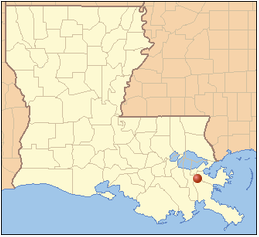| Home | Search | Emissions | Pollutants | About the Database |

Phillips 66 (2418), Belle Chasse
LDEQ Accident Report
| Accident # | 153687 |
| State Police # | 14-00565 |
| Accident Date | 2014-02-04 |
| Report Date | 2014-02-11 |
| Follow-up Date | 2014-10-17 |
| Follow-up: | Yes |
Pollutants Released
| Pollutant | Duration | Point Source | Greenhouse Gas | Criteria Pollutant | Ozone forming chemical | Amount of Release |
| Sulfur Dioxide | 9h 30m | Amine Feed/Effluent Exchangers bank | NO | YES | NO | 19,306.0 pounds |
Accident Classified As: Reportable Quantity
Cause of Problem: Equipment Failure
On 2/4/14, the amine stripper vessel experienced an upset involving its Amine Feed/Effluent Exchangers bank; this resulted in an unexpected high level in the stripper's reflux drum causing Rich Amine to contaminate the Lean Amine that circulates to various amine contactors throughout the refinery. Unable to established proper levels at the amine stripper, vessel stripper efficiencies were minimal which resulted in increased levels of hydrogen sulfide in the Refienry's fuel gas system. The increased levels of hydrogen sulfide subsequently caused all on-line heaters and one supplemental boiler to exceed for a period of time their permitted sulfur dioxide emissions limits. A Root Cause Analysis (RCA) investigation was completed and revealed that bolt failures due to amine and sulfide stress cracking in the 591-X-4B exchanger bundle floating head caused rich amine to immediately saturate teh lean amine with hydrogen sulfide inside of the heat exchanger shell. With the amine saturated and unable to absorb hydrogen sulfide at the fuel gas conractors, hydrogen sulfide in fuel gas spiked above exceedance limits.
Discharge Preventable - No
Unexpected upset involving the Amine Feed/Effluent Exchangers quickly causing reduced amine stripper efficiencies.
Notes/Remedial Actions
Reduced acid gas feed make by immediately implementing the sulfur shedding plan documented in the Refinery's PMO plan (consent decree required) for the remaining Refinery operating units. The following corrective actions were identified: 1) Replace the existing 591-X-4A/B/C floating head bolting with stainless steel bolting material to eliminate sulfide stress cracking 2) Evaluate bolts used in other exchangers to make sure the metallurgy is compatible with the service of the exchanger 3) Identify additional equipment that is susceptible to sulfide stress cracking adn evaluate their bolting material metallurgy

Connect With Us: